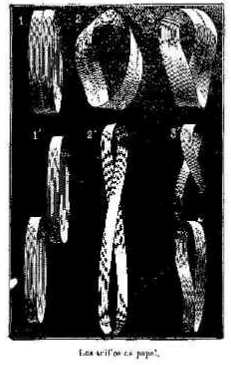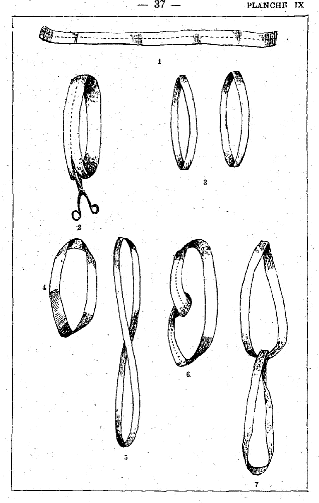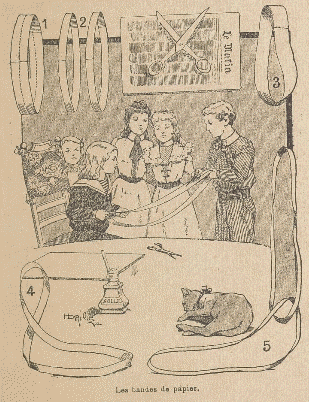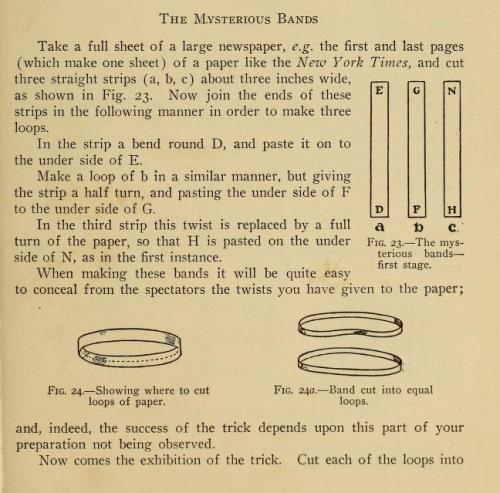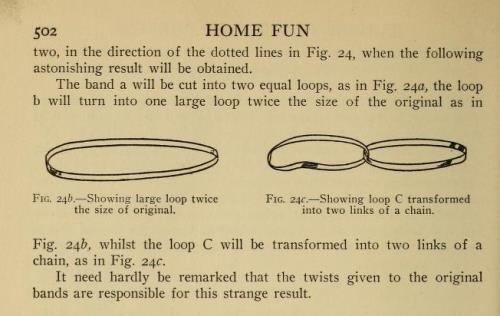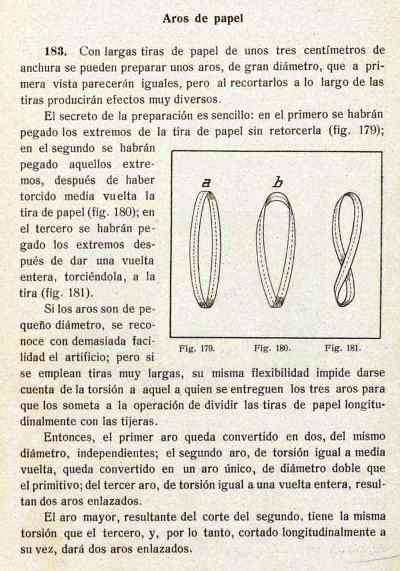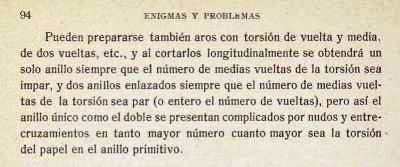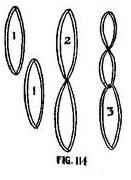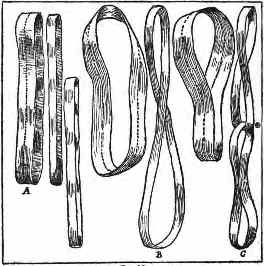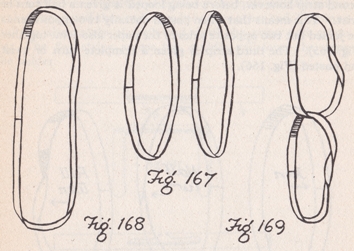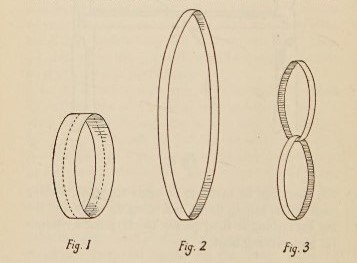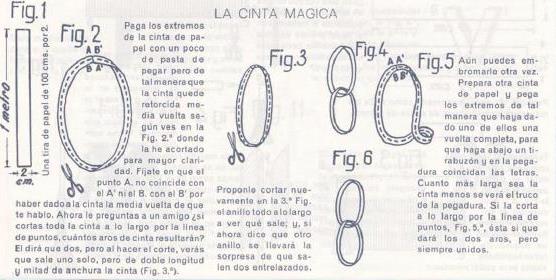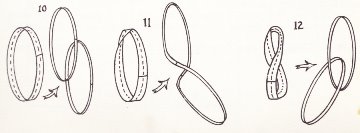| The Public Paperfolding History Project
Last updated 25/3/2025 x |
|||||||
| The Afghan Bands / Les Anneaux Mysterieuse | |||||||
This page is being used to collect information about the history of the paperfolding magical effect known as the Afghan Bands / Les Anneaux Mysterieuse. Please contact me if you know any of this information is incorrect or if you have any other information that should be added. Thank you. The Afghan Bands is a self-working magical effect in which three apparently identical long loops of paper (or sometimes cloth) are cut (or sometimes torn) lengthwise to produce first two separate loops, then a single double-length loop, and finally two interlocked loops. The first loop is a simple untwisted loop, the second a Mobius Strip and the third a fully twisted loop. According to https://geniimagazine.com/wiki/index.php?title=Afghan_Bands 'The first professional magician to perform the effect was Felicien Trewey in the late 1800s' and 'Percy Selbit was the first to describe the Möbius strip as a method for a magic trick in the English language in 1901, coining the name 'Afghan Bands'.' I have not been able to find the original source for this information. ********** 1887 As far as I am aware the first publication of this effect was in 'La Nature' 709 of 1st January 1887, in an article headed 'Recreations Scientifique' and subheaded 'Les Anneaux de Papier'. This article is attributed to Dr Z...'. I do not know whose nom de plume this is.
********** 'Neues Spielbuch fur Madchen', by Jeanne Marie von Ganette-Georgens, which was published in Berlin in 1887 contains a small section which explains how to make two rings out of one (Zwei Rings aus einem machen)
********** The Afghan Bands also appear: 1888 As 'Les anneaux de papier'in the 5th Edition of 'Les Recreations Scientifiques' by Gaston Tissandier was published in Paris by G. Masson in 1888.
********** 1890 As 'The Paper Rings' in 'Half Hours of Scientific Amusement' by Gaston Tissandier, translated by Henry Frith, which was published by Ward, Lock and Co in London, New York and Melbourne in 1890, as 'The Paper Rings'.
********** 1893 In Volume 2 of 'The Picture Magazine' for July to December 1893.
********** 1896 As 'Los anillos de papel' in 'Repertorio Completo de Todos los Juegos', which was published in Madrid in 1896
********** 1899 In 'Le Livre des Amusettes' by Toto, which was published in Paris by Charles Mendel in 1899.
********** 1906 As 'Les Bandes de Papier' in 'Les Bon Jeudis' by Tom Tit, which was published in Paris in 1906.
********** 1907 In issue 1503 of 'The Boy's Own Paper' of 2nd November 1907.
********** 1910 As 'The Mysterious Bands' in 'Home Fun' by Cecil H Bullivant, which was published by Dodge Publishing Company in New York in 1910.
********** 1918 In 'Ciencia Recreativa' by Jose Estralella, which was published by Gustavo Gili in Barcelona in 1918.
********** In 'Pasatiempos: Juegos Figuras Problemas Con Papel y Tigeras' (Games, Figures, Problems with Paper, Scissors), which was published by Editorial Muntanola in Barcelona, probably c1918.
********** 1920 In Will Blyth's 'Paper Magic, first published in London in 1920, as 'An Episode of Mere Man'.
********** 1922 In 'Houdini's Paper Magic' first published in New York in 1922, as 'Trewey's Paper Rings'.
********** 1928 In 'Fun with Paperfolding' by Murray and Rigney, published in New York in 1928, as 'The Mystery Loops'.
********** 1932 In 'Winter Nights Entertainments' by R M Abraham, which was first published by Constable and Constable in London in 1932, as 'Cutting the Paper Rings'. The effect is described but no illustration is given.
********** 1936 As 'The Mystic Paper Rings' in 'More Things Any Boy Can Make' by Joseph Leeming, which was published by D Appleton-Century Company in New York and London in 1936.
********** 1939 As 'The Magic Paper Rings' in 'Fun with Paper' by Joseph Leeming, which was published by Spencer Press Inc in Chicago in 1939.
********** 1951 As 'La Cinta Magica' in the extended version of 'El Mundo de Papel' by Dr Nemesio Montero, which was published by G Miranda in Edicions Infancia in Valladolid in 1951.
********** 1960 As 'The Afghan Bands' in 'Paper Folding Fun' by Robert Harbin, which was published by Oldbourne in London in 1960.
********** 1961 A simplified version in which one band is cut into two linked bands appears in the 1961 Rupert annual under the title 'The Conjuror's Paper Chain' ********** 1963 As 'Mystic Paper Bands' in 'Fell's Guide to Papercraft: Tricks, Games and Puzzles' by Walter B Gibson, which was published by Frederick Fell Inc in New York and George McLeod Ltd in Toronto in 1963.
********** |
|||||||

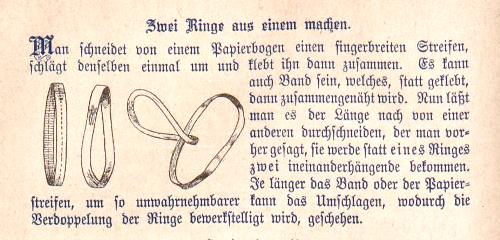


%20p349%20b.jpg)
